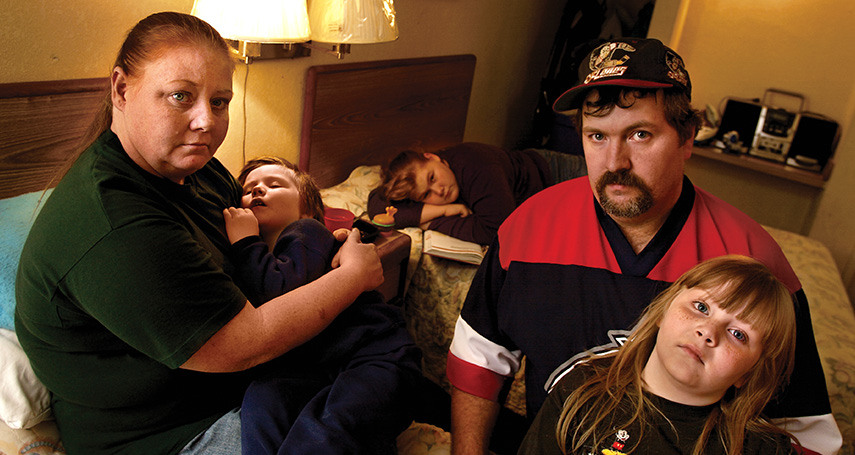Housing affordability and income inequality deeply affect children and youth. During the 2020-21 school year, public schools identified 1,099,221 students who experienced homelessness, representing 2.2% of all students enrolled in public schools—meaning 1 in every 45 children enrolled in public schools is unhoused (see Table 9). Inequities persist for students with additional identifiers of race, immigration, and disability status:
- A disproportionate number of unhoused students are English learners and children with disabilities—the largest two subgroups of students who experience homelessness. Students with disabilities constitute 15% of public school students.24
- Three out of four students who experience homelessness are children of color. While Hispanic students account for 28% of all students enrolled in public schools, they represented 39% of students who experience homelessness. Similarly, Black students account for 15% of students overall, but 24% of students who experience homelessness.25
Housing is often seen as the foundation for economic well-being and security for children, youth, and families. For Black and Brown families who face additional systemic obstacles, access to stable housing can be a catalyst for better social, health, and economic outcomes. And while the number of unhoused children enrolled in public schools has declined in recent years, dropping by 14% from 1.27 million to 1.09 million between the 2019-20 and 2020-21 school years, it is important to put these declines into context (see Table 9):
- In the first full school year during the pandemic, schools had difficulty identifying unhoused students partly due to COVID-19 disruptions. Many schools suggested that fewer students were counted as unhoused, not because their families had found housing but because schools could not identify all students experiencing homelessness.
- In reality, homelessness today is up by 63% from 15 years ago. In addition, greatly overrepresenting unhoused students are children of color. Three out of 4 students who experience homelessness are children of color.26
The lack of affordable housing, discrimination in access to housing and resources, and income inequality plays a large role in the rise of homelessness and housing insecurity for millions of American families. In fact, rent is out of reach for low-wage workers in every state (see Table 8):
- The average monthly fair market rent (FMR) for a two-bedroom rental in the United States is $1,342, much higher than what full-time workers earning the minimum wage can afford.
- In 2022, rents were so high that a person working full-time, year-round at minimum wage could not afford a modest two-bedroom rental unit in any state or the District of Columbia and still have enough money for food, utilities, and other necessities.
To afford FMR for a two-bedroom rental nationally, a single person working full-time must make almost $26 an hour, more than 3.5 times the federal minimum wage of $7.25 an hour. And while 30 states and the District of Columbia now have minimum wages higher than the federal minimum wage, the average minimum-wage worker must still work 96 hours per week—nearly 2.5 full-time jobs—to afford a two-bedroom rental. Even in states with the most affordable housing, Arkansas, Missouri, and New Mexico, a family still must have at least 1.5 full-time jobs at minimum wage to afford a two-bedroom rental. In the least affordable states, New Hampshire and Hawaii, it takes 3.6 and 4 full-time jobs at minimum wage, respectively, to afford housing.
Inevitably, minimum-wage-earning families with children do not have the resources to retain full-time employment, secure stable housing, and still create quality time with their children to ensure their healthy development and growth. Additionally, the states of Alabama, Louisiana, Mississippi, South Carolina, and Tennessee do not require a minimum wage. The District of Columbia, Washington, and California have the highest minimum wages at $16.50, $15.74, and $15.50, respectively.
Despite increases in the minimum wage, a living wage is still out of reach in most states. For instance, Virginia’s increase in the minimum wage from $7.25 to $12.00 catapulted the state’s ranking in housing affordability today compared to 2020, despite no changes to its $1,342 FMR. Yet a Virginia family still needs 2.3 full-time jobs at the current minimum wage to afford a two-bedroom rental, up from 3.3 jobs two years ago.
Homelessness can alter cognitive and physical development for children and youth through risks similarly associated with a low socioeconomic status like heart disease, hypertension, obesity, certain cancers, and mental illnesses, as well as exposure to environmental risk factors.27
Policy makers must address systemic racism, income inequality, and greater resources in housing affordability and homelessness for immigrant and undocumented children. Creating mandates for a livable wage, removing barriers to access housing, like work requirements and term limits, and providing inclusive benefits for immigrants will make great strides to ensure there are no unhoused people. America’s children and youth rely on stable housing to learn at school, develop cognitively, and grow in a safe and secure environment.
[24] National Center for Homeless Education. 2022. “Student Homelessness in America: School Years 2018-19 to 2020-21,” Table 1. https://nche.ed.gov/wp-content/uploads/2022/11/Student-Homelessness-in-America-2022.pdf
[25] Ibid.
[26] National Center for Homeless Education. 2022. “Student Homelessness in America: School Years 2018-19 to 2020-21,” Table 1. https://nche.ed.gov/wp-content/uploads/2022/11/Student-Homelessness-in-America-2022.pdf
[27] Centers for Disease Control and Prevention. (2023, March 6). Homelessness as a public health law issue . Centers for Disease Control and Prevention. Retrieved March 15, 2023, from https://www.cdc.gov/phlp/publications/topic/resources/resources-homelessness.html

